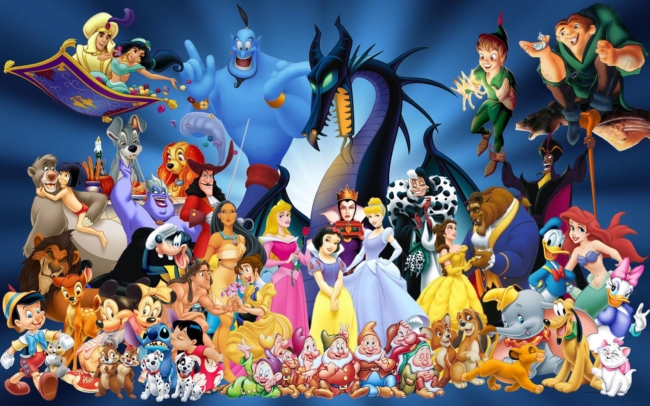As children, we are naturally shielded from the forces of evil, our innocence and naivety blinds us from some of the harsh realities of life. Disney lets these forces in for the first time. These characters and their experiences become a catalyst for children.

We have undoubtedly entered the era of Disney reboots, re-makes and sequels. It all began in 1996, when Disney’s 101 Dalmations returned to the screens in a live-action reboot. It surprised audiences, but it was a thrilling success. Fourteen years later, audiences welcomed Disney’s live-action remake of Alice in Wonderland. It was another huge financial success, bringing in over US$ 1 billion. Disney saw the potential and it marked a new direction for the studio. Since then we have seen The Sorcerers Apprentice (a 2010 remake of Fantasia), Maleficent (a 2014 take on Sleeping Beauty), Cinderella (2015), and just this year alone we saw re-boots of The Jungle Book, The BFG and Pete’s Dragon. Next year we will see a remake of The Beauty and the Beast and also in the works are plans for The Little Mermaid, Dumbo, Mulan, Peter Pan, Tinkerbell and Whinnie The Pooh.
[symple_heading style=”” title=”Disney Reboots, re-makes and sequels are clearly the driving force in the film industry right now, but why?” type=”h1″ font_size=”” text_align=”left” margin_top=”30″ margin_bottom=”30″ color=”undefined” icon_left=”” icon_right=””]
Disney first pioneered it’s universe in 1937 with Snow White and The Seven Dwarves. Over the next six decades what followed was nothing short of magical. Disney gripped the imaginations of every generation as they told the tales of princes and princesses from far away lands. As their universe expanded, so did their potential.
For most of us, we grew up with Disney. Whether you were born in the 90’s, 60’s or even the 30’s, these movies have been a part of our childhood. They remain the staple for most Hollywood cinema and television. But what is it that makes them so fulfilling? Is it the idea of eternal happiness? Is it some attempt to cling to the hope that perhaps everything will all work out, we will find our prince charming and live happily ever after in a gigantic white castle in some far far away kingdom?
What makes these Disney tales so remarkable is their enduring appeal to members of all generations. They’re diverse and adaptable. These tales appeal to children, parents and a generation of adults. Brimming with layer upon layer of meaning and resonance, each inference is peeled back as we grow older and find ourselves delving deeper into the narratives and characters. As a child, when we watch The Lion King we are taken on an emotional journey. We find light in the moments between Timon and Pumba, yet we recognise the sadness felt by Simba as he lies in the arms of his Father. As an adult, we are taken on a different journey. As our life experiences evolve, so does our understanding of these tales. We understand and empathise the grief felt by Simba and Shenzi, not just as a lion cub, but as a child who has lost their father, or a wife who has lost her husband. These stories connect to every individual on many different levels, and the older we get, the more they evolve.

Disney movies aren’t just a source of entertainment. These films tackle real issues and reinforce important messages. At the most basic level Disney teaches us some of life’s most important lessons. To distinguish between good and evil. The importance of compassion and kindness. But most importantly, resilience. As children, we are naturally shielded from the forces of evil, our innocence and naivety blinds us from some of the harsh realities of life. Disney lets these forces in for the first time. These characters and their experiences become a catalyst for children. They play a service to us by enriching our understanding of concepts like grief and gratitude. The concept of death is so foreign to us as children, we all remember the shocking death of Bambi’s mother, the trembling echo of the gunshot that will always haunts us. It evoked emotions within us so unrecognisable yet so enduring. 20 years later we still shed a tear.
These characters and their tales are so adaptable. It’s a notion that Disney has proved time and time again through each reboot, remake or sequel. Maleficent (2014) begins with a mystifying quote from Angelina Jolie (Maleficent); “Let us tell an old story anew, and we will see how well you know it”. It’s a quote that encompasses Disney in the 21st century. An unusual take on Sleeping Beauty, as it’s told from the perspective of the villain, Maleficent brings the concept of the ‘fairy tale’ into modern society. We are compelled by her love affair with good and evil, vengeance and forgiveness. Instead of exploring Maleficent’s character as the villain, we finally begin to understand her path for retribution. As we have become so conditioned to the cliched romance plot, we wait hopelessly for the prince to swoop in and save the damsel with true loves first kiss. This is not the case. The film rethinks the typical fairy tale by questioning the notion of ‘true love’. The film explores this notion through the relationship between Maleficent and Aurora, a mother and daughter, no matter how they came to find one another. Ultimately it is Maleficent’s kiss that saves Aurora. A truly remarkable moment for Disney and all modern fairy tales.
Disney’s success is predicated on nostalgia. The Walt Disney studio is 92 years old, but the appeal hasn’t aged a day. Our parents took us to see a Disney film, and their parents took them to see a Disney film, and we will no-doubt take our children to see Disney films.
We will never escape these tales, whether we want to accept it or not, there is a Peter Pan within all of us, a child that will never grow old.







